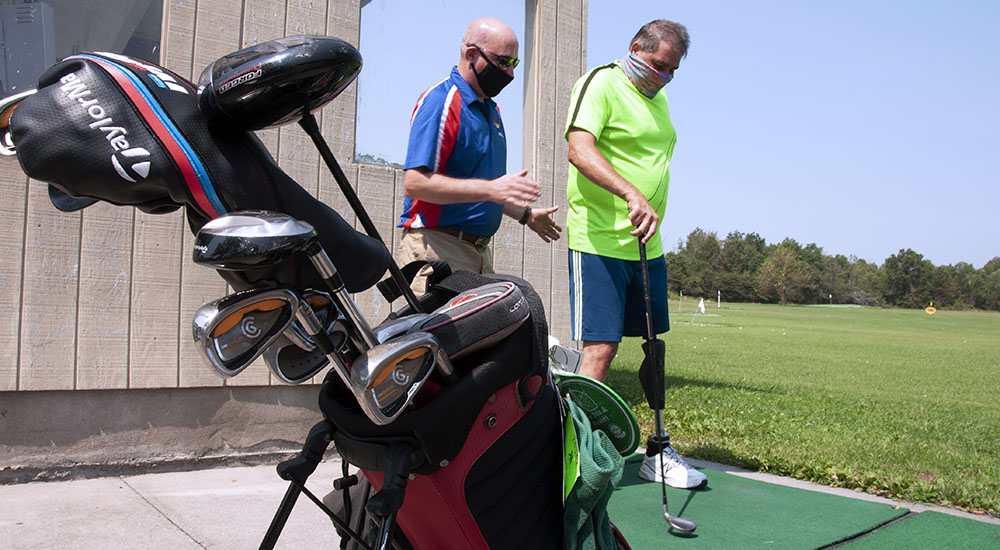With everyone indoors during spring and summer, and restricting physical activity to the confines of living rooms and basements, the New York Harbor Healthcare System’s prosthetics team – and the Veterans they serve – had to adapt and overcome.
But adapting to new challenges is a part of who they are.

Golf can be adaptable to a wide array of impairment groups including individuals with limb loss. Exercises and golf-specific activities can be tailored to achieve the requisite strength, flexibility and balance to successfully participate in the sport.
The smell of freshly cut grass and bright warm sun at the Toptracer Golf Course and Driving Range was a pleasant change of pace for a Thursday afternoon.
Golf courses and driving ranges avoid the restrictions affecting other recreational activities because of the physically distant nature of the sport.
Physical therapy session at the driving range
“Because of the restrictions regarding physical distancing, we’ve had to think outside the box. I sought out this opportunity to bring some Vets out here to the driving range for a physical therapy session,” Dr. Jonathan Glasberg, clinical coordinator for the VA prosthetics team covering New York and New Jersey said.
Glasberg arrived decked out in a red, white and blue polo shirt, khaki shorts, a baseball hat, and sunglasses looking the part of a quintessential golfer.
William “Bill” Alvarez arrived a few minutes later, riding a bright red electric scooter, U.S. Army sticker affixed to the front, and a tote bag housing a hand towel and a bottle of water. He’s in the white shirt in the photo above.
A Veteran of the 101st Airborne Division who served in Vietnam, his right leg was amputated from the knee down, as well as his left leg at the ankle. He now wears prosthetic legs which allow him to stay active and stay mobile.
“I started doing adaptive sports with New York VA about six years ago, beginning with hand cycle marathons. The first one I did was Pedals with Honor in Central Park. Got all the way around the park, and I had the handbrake on! That was my introduction to adaptive sports.”
As Glasberg laid out a training mat and an exercise ball for warm-up repetitions, Alvarez explained that transporting training equipment is usually the biggest hurdle for adaptive sports.
“I never thought I’d be able to do a marathon. It was very hard, but I kept going. Once I finished my first marathon, I thought to myself, ‘I wonder what else I can do?’ So now I’m here with Jonathan learning to golf for the first time in my life.”
The importance of staying active
After some stretching and calisthenics, Glasberg showed Alvarez how to properly hold a golf club while staying balanced. Alvarez sent a few golf balls flying down range.
While they trained, they discussed the importance of staying active.
“There are different types of prosthesis. We mostly use suction sockets, which requires a technician to measure and ‘fit’ a prosthetic. When people gain or lose weight, or otherwise change their physiology, it affects how the prosthetic fits. It’s a constant, ongoing relationship with your health care provider,” Glasberg said.
As Alvarez’s physical therapy session came to an end, he thanked Glasberg for teaching him how to golf.
“Who knew that when all this began I’d be learning how to do something totally new! I don’t know what I’d do without the amazing staff at New York VCA. Thank you.”
The Veteran in the top photo is Dominic Romano.
Michael A. Drake is a public affairs officer for VA New York.
Topics in this story
More Stories
Study underscores important role COVID vaccination can have in protecting Veterans from infection and reducing long-term health consequences
Columbia VA’s robotic surgery teams completed their 800th robotic surgery and are on schedule to hit 1,000 by the end of the year.
In a decentralized clinical trial, Veterans can participate from their own homes or local VA instead of having to travel to a research site.






